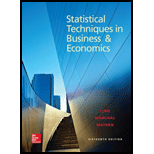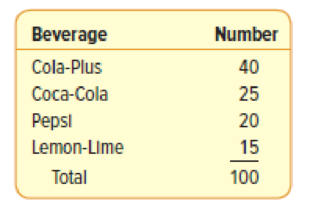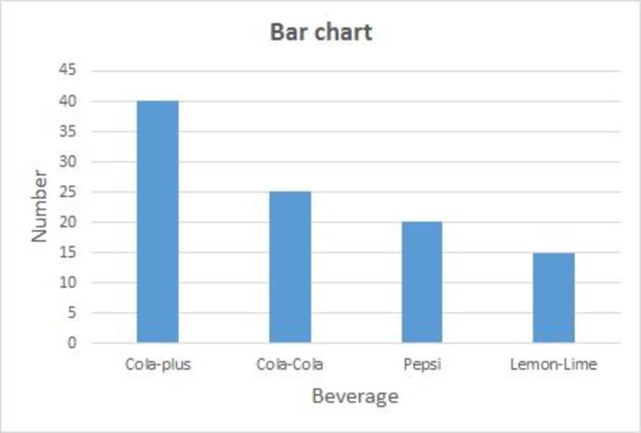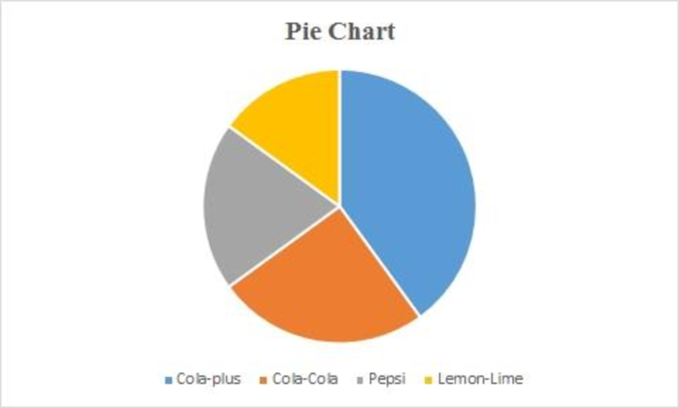
Concept explainers
DeCenzo Specialty Food and Beverage Company has been serving a cola drink with an additional flavoring, Cola-Plus, that is very popular among its customers. The company is interested in customer preferences for Cola-Plus versus Coca-Cola. Pepsi, and a lemon-lime beverage. They ask 100 randomly sampled customers to take a taste test and select the beverage they prefer most. The results are shown in the following table:

- (a) Is the data qualitative or quantitative? Why?
- (b) What is the table called? What does it show?
- (c) Develop a bar chart to depict the information.
- (d) Develop a pie chart using the relative frequencies.
a.
Identify the nature of the data whether it is qualitative or quantitate.
Explain your answer.
Answer to Problem 1SR
The nature of the data is quantitative.
Explanation of Solution
The given table explains the frequencies of different cola drinks with additional flavors that people prefer the most. The number of people who liked each flavor of cola drink is represented as numerical values. Therefore, the nature of the data is quantitative.
b.
Identify the name of the table.
Explain what does the table represents.
Answer to Problem 1SR
The given table is called as the frequency table.
The table explains the frequencies of different cola drinks with additional flavors that people prefer the most.
Explanation of Solution
Frequency table:
The frequency table is a collection of mutually exclusive and exhaustive classes that show the number of observations in each class.
Here, the given table explains the frequencies of different cola drinks with additional flavors that people prefer the most. Therefore, the given table is called as the frequency table.
c.
Construct a bar chart to depict the given information.
Answer to Problem 1SR
The bar chart for the given data is represented as follows:

Explanation of Solution
The bar chart for the given data can be drawn using EXCEL.
Step-by-step procedure to obtain bar chart using EXCEL is given below:
- Select the total data range with labels.
- Go to Insert > Charts > Bar chart.
- Select the appropriate bar chart.
- Click OK.
d.
Construct a pie chart using the relative frequencies.
Answer to Problem 1SR
The pie chart for the given data is represented as follows:

Explanation of Solution
The pie chart for the given data can be drawn using EXCEL.
Step-by-step procedure to obtain pie chart using EXCEL is given below:
- Select the total data range with labels.
- Go to Insert > Charts > pie chart.
- Select the appropriate pie chart.
- Click OK.
Want to see more full solutions like this?
Chapter 2 Solutions
Statistical Techniques in Business and Economics
- Question 2: When John started his first job, his first end-of-year salary was $82,500. In the following years, he received salary raises as shown in the following table. Fill the Table: Fill the following table showing his end-of-year salary for each year. I have already provided the end-of-year salaries for the first three years. Calculate the end-of-year salaries for the remaining years using Excel. (If you Excel answer for the top 3 cells is not the same as the one in the following table, your formula / approach is incorrect) (2 points) Geometric Mean of Salary Raises: Calculate the geometric mean of the salary raises using the percentage figures provided in the second column named “% Raise”. (The geometric mean for this calculation should be nearly identical to the arithmetic mean. If your answer deviates significantly from the mean, it's likely incorrect. 2 points) Starting salary % Raise Raise Salary after raise 75000 10% 7500 82500 82500 4% 3300…arrow_forwardI need help with this problem and an explanation of the solution for the image described below. (Statistics: Engineering Probabilities)arrow_forwardI need help with this problem and an explanation of the solution for the image described below. (Statistics: Engineering Probabilities)arrow_forward
- 310015 K Question 9, 5.2.28-T Part 1 of 4 HW Score: 85.96%, 49 of 57 points Points: 1 Save of 6 Based on a poll, among adults who regret getting tattoos, 28% say that they were too young when they got their tattoos. Assume that six adults who regret getting tattoos are randomly selected, and find the indicated probability. Complete parts (a) through (d) below. a. Find the probability that none of the selected adults say that they were too young to get tattoos. 0.0520 (Round to four decimal places as needed.) Clear all Final check Feb 7 12:47 US Oarrow_forwardhow could the bar graph have been organized differently to make it easier to compare opinion changes within political partiesarrow_forwardDraw a picture of a normal distribution with mean 70 and standard deviation 5.arrow_forward
- What do you guess are the standard deviations of the two distributions in the previous example problem?arrow_forwardPlease answer the questionsarrow_forward30. An individual who has automobile insurance from a certain company is randomly selected. Let Y be the num- ber of moving violations for which the individual was cited during the last 3 years. The pmf of Y isy | 1 2 4 8 16p(y) | .05 .10 .35 .40 .10 a.Compute E(Y).b. Suppose an individual with Y violations incurs a surcharge of $100Y^2. Calculate the expected amount of the surcharge.arrow_forward
- 24. An insurance company offers its policyholders a num- ber of different premium payment options. For a ran- domly selected policyholder, let X = the number of months between successive payments. The cdf of X is as follows: F(x)=0.00 : x < 10.30 : 1≤x<30.40 : 3≤ x < 40.45 : 4≤ x <60.60 : 6≤ x < 121.00 : 12≤ x a. What is the pmf of X?b. Using just the cdf, compute P(3≤ X ≤6) and P(4≤ X).arrow_forward59. At a certain gas station, 40% of the customers use regular gas (A1), 35% use plus gas (A2), and 25% use premium (A3). Of those customers using regular gas, only 30% fill their tanks (event B). Of those customers using plus, 60% fill their tanks, whereas of those using premium, 50% fill their tanks.a. What is the probability that the next customer will request plus gas and fill the tank (A2 B)?b. What is the probability that the next customer fills the tank?c. If the next customer fills the tank, what is the probability that regular gas is requested? Plus? Premium?arrow_forward38. Possible values of X, the number of components in a system submitted for repair that must be replaced, are 1, 2, 3, and 4 with corresponding probabilities .15, .35, .35, and .15, respectively. a. Calculate E(X) and then E(5 - X).b. Would the repair facility be better off charging a flat fee of $75 or else the amount $[150/(5 - X)]? [Note: It is not generally true that E(c/Y) = c/E(Y).]arrow_forward
 Glencoe Algebra 1, Student Edition, 9780079039897...AlgebraISBN:9780079039897Author:CarterPublisher:McGraw Hill
Glencoe Algebra 1, Student Edition, 9780079039897...AlgebraISBN:9780079039897Author:CarterPublisher:McGraw Hill Big Ideas Math A Bridge To Success Algebra 1: Stu...AlgebraISBN:9781680331141Author:HOUGHTON MIFFLIN HARCOURTPublisher:Houghton Mifflin Harcourt
Big Ideas Math A Bridge To Success Algebra 1: Stu...AlgebraISBN:9781680331141Author:HOUGHTON MIFFLIN HARCOURTPublisher:Houghton Mifflin Harcourt Holt Mcdougal Larson Pre-algebra: Student Edition...AlgebraISBN:9780547587776Author:HOLT MCDOUGALPublisher:HOLT MCDOUGAL
Holt Mcdougal Larson Pre-algebra: Student Edition...AlgebraISBN:9780547587776Author:HOLT MCDOUGALPublisher:HOLT MCDOUGAL College Algebra (MindTap Course List)AlgebraISBN:9781305652231Author:R. David Gustafson, Jeff HughesPublisher:Cengage Learning
College Algebra (MindTap Course List)AlgebraISBN:9781305652231Author:R. David Gustafson, Jeff HughesPublisher:Cengage Learning



